|
Handheld Algiz RT8
Powerful, state-of-the-art, ultra-rugged 8-inch Android tablet for work in demanding environments
(by Conrad H. Blickenstorfer; Photography by Carol Cotton; for brief capsule review, see here)
Share on:



Swedish Handheld Group announced the Android 9-based 8-inch Algiz RT8 tablet in early 2020 as the latest in the company's lineup of rugged mobile computers for field workers in all sorts of demanding environments. Sleek and handy but with a display considerably larger than even the biggest smartphones, the Algiz RT8 was designed from the ground up for work in the field.
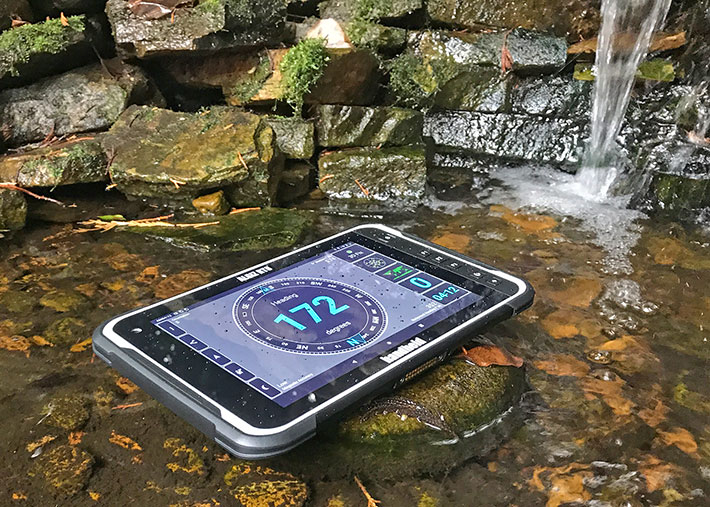
In terms of overall device lineup, the Handheld Group offers two primary product lines, those being the "Nautiz" branded rugged handhelds and the "Algiz" branded rugged tablets. By now, most of the Nautiz handhelds are Android-based, with some still available with either Android or the old Microsoft Windows Embedded Handheld.
On the Algiz tablet side, the Handheld Group also supports both Android and (full) Windows, and now, with the new Algiz RT8, there are two tablets with Windows and two with Android. The image below shows the company's entire current tablet lineup.
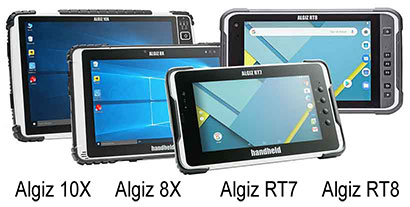 As usual, let's answer some basic questions first. Why a rugged 8-inch Android tablet when Handheld already has an excellent rugged 8-inch Windows tablet (the Algiz 8X)? As usual, let's answer some basic questions first. Why a rugged 8-inch Android tablet when Handheld already has an excellent rugged 8-inch Windows tablet (the Algiz 8X)?
Answer: Android is coming on ever stronger in tablets, too. And with smartphones now pushing into 7-inch screens, it made perfect sense to offer a device with a display bigger than anything available in a smartphone for those who like or need a true tablet. Hence the Algiz RT8 as a larger and more powerful complement to the still available 7-inch Algiz RT7.
While the smartphone market is dominated by Android (about 86% of the market) and Apple (the remaining 14%), the situation is less clear in tablets. Google's focus with Android is clearly on smartphones, and almost all Android apps are designed and formatted for smartphones. As a result, both Windows and Android have a strong presence in tablets, with Windows working best on larger tablets and Android best on smaller screens. Handheld realized this would happen and positioned itself perfectly: they have now 7 and 8-inch rugged tablets with Android, 8 and 10-inch rugged tablets with Windows.
What Handheld offers with the Algiz RT8
The Algiz RT8 is an entirely new product for Handheld, and for customers both an alternative as well as a complement to Handheld's existing smaller Algiz RT7. Here's what customers get with the Algiz RT8:
- Excellent display — The Algiz RT8 display measures 8 inches diagonally and has full 1,920 x 1,200 pixel resolution. That makes it sharper than any of Apple's iPad Pro models. The 16:10 aspect ratio looks pleasing to the eye — not too boxy and not too wide. With almost 500 nits luminance, the Algiz RT8 screen is much brighter than your average laptop and up there with premium consumer tablets.
- Capacitive multi-touch — Capacitive multi-touch has totally taken over in handhelds and tablets, and the Algiz RT8 has it. It works smoothly and responsively as users — spoiled by modern consumer smartphones and tablets — have come to expect. And the RT8's glove and rain mode make it that much better and easier to use outdoors.
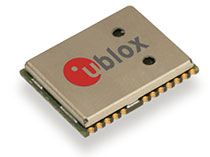 - Concurrent GNSS — For positioning, the Algiz RT8 uses a dedicated u-blox NEO-M8N module with support for all major global GNSS systems (GPS, GLONASS, Galileo, and BeiDou). That means the receiver can not only use the satellites of the US GPS, but also those of other nations' positioning systems. Having more satellites for determining position improves positioning accuracy under adverse conditions or in areas with poor coverage.
- Android 9 GMS — The Algiz RT8 comes standard with the full GMS version of Android. GMS stands for Google Mobile Services, which means access to the Google app store and all of Google's popular productivity apps either installed or available for download. Handheld also includes its own enterprise-grade MaxGo configuration and staging manager software.
- Packs a punch — Many rugged Android tablets use "compromise" processors that support either Android or Windows, neither of which well. Handheld gave the Algiz RT8 one of the Android-dedicated "SnapDragon" ARM processors that power numerous premium consumer phones and tablets.
- Fresh modern look — The Handheld Group has long excelled in their styling sense and expertise, and the sleek new Algiz RT8 is no exception. The flush glass surface of the capacitive screen extends past the LCD perimeter, giving the tablet an elegant and contemporary look.
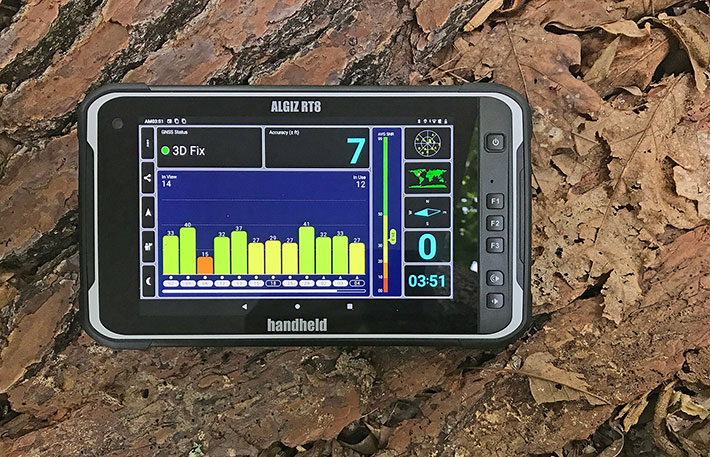
One glance at the Algiz RT8 makes it clear what kind of rugged Android tablet Handheld felt would work best for its customers. A rugged Android tablet must not just be a big phone with some extra protection; it must provide true value-added. It must be designed and built rugged from the inside out, and it must be able to do things phones just cannot. It also should be reasonably quick, because the global smartphone performance and features race has spoiled the literally billions of Android smartphone users, and they now expect the same or better from their professional tools.
The hardware
As you'd expect, Handheld did it their way. Throughout its entire history, the company has pursued a consistent design language and consistent color palettes. Handheld Group devices always have visual brand identity rivaled only by the Panasonic Toughbook brand. You know a Handheld device when you see one, and the Algiz RT8 is no exception.
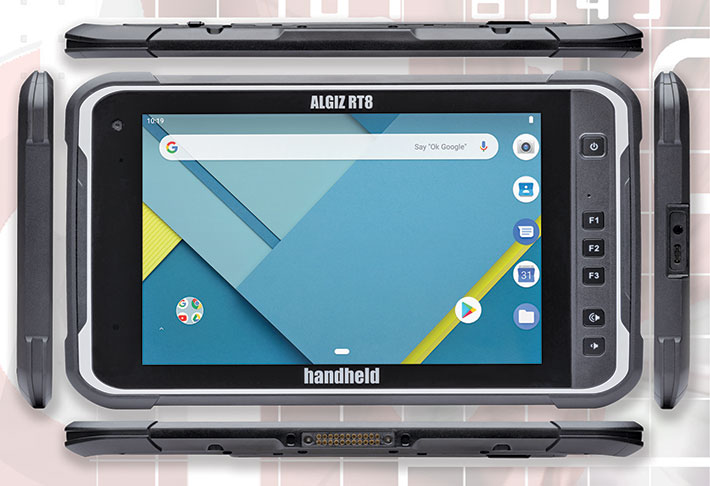
Handheld has consistently hit the sweet spot between using enough of the consumer tablet and smartphone look and feel to be attractive and appealing, but also enough real-world features and practicality to prevail on the job. The RT8 is a good looking piece of equipment, but it has enough of a bezel to protect the display and to be held and handled without the screen going nuts (tablets with zero bezel and wrap-around screens, we're looking at you). There are actual physical, programmable buttons, because out there on the job it's sometimes better to have push buttons than tapping on a touch screen.
The image below shows the right side of the Algiz RT8. It's the only side with any sort of conventional ports. We're talking Android in the new era of wireless everything and small, reversible USB Type-C ports. And although the Algiz RT8 carries IP67 ingress protection, it doesn't even need a protective cover for the USB and audio ports.

But what about HDMI or wired Ethernet or more USB? That's all available via the surface-mount docking connector along the bottom side of the Algiz RT8.
Construction and components
The picture below shows, on the left, the backside of the tablet with its battery compartment door in place and locked. Note the expansion connector for bolt-on modules above the battery compartment. To the left of the expansion area is the rear camera and flash. Below that an external antenna pass-through with a protective cap. On the right of the image is the backside with the battery and battery compartment door removed.
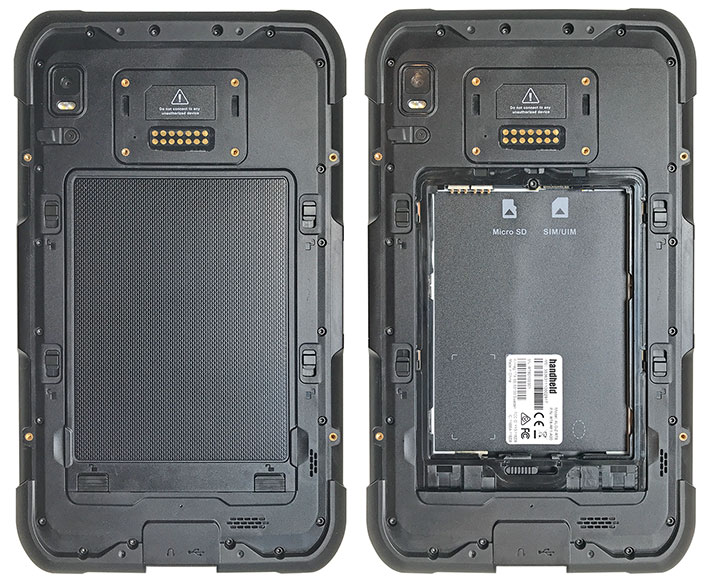
Unlike almost all consumer tablets, the Algiz RT8 has an easily accessible replaceable battery. It's a 31.16 watt-hour (3.8V/8,200mAh) 4-1/2 x 3-5/16 x 3/16 inch rechargeable Li-Ion battery that sits in a compartment in the back of the tablet. 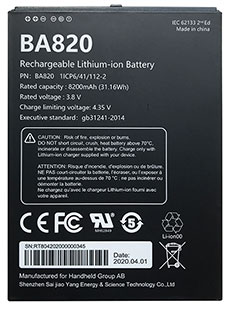 Unlike the battery in Handheld's Windows 10-based Algiz 8X where the battery is part of the design and there is no battery compartment cover, the RT8 battery does require a cover that has a white silicone pressure seal around its entire perimeter. Unlike the battery in Handheld's Windows 10-based Algiz 8X where the battery is part of the design and there is no battery compartment cover, the RT8 battery does require a cover that has a white silicone pressure seal around its entire perimeter.
Since the battery compartment is open to the inside of the tablet, it's crucial to examine the seal for nicks or other damage every time the cover is put back in place. No fewer than six snaps securely lock the battery compartment cover in place. There is no chance that it will come loose by mistake.
Inside the battery compartment you find the tablet's micro SDXC card slot that can handle cards up to 128GB, and next to it a nano-SIM slot.
As far as construction goes, the Handheld Algiz RT8 housing consists of a black polycarbonate plastic bucket-style back, and a front light-gray polycarbonate plastic assembly that fits into the back. The two parts are held together via about 20 small hex socket head screws, thankfully all of the same 1/16 size.
A tongue-and-groove rubber seal design keeps dust and moisture/liquids from penetrating. The tongue is hard plastic and part of the bottom half of the housing; the groove around the perimeter of the front part has an orange replaceable rubber/silicone O-ring seal that's easy to see and easy to fit.
Once all the hex socket head screws holding the two parts of the housing together have been removed, you can carefully push the front part of the housing out of the rear bucket. Carefully, because there is a ribbon between the two halves that goes between the mother board and the main docking connector. Two other connections between the halves are handled via spring-loaded pogo pins. A good solution.
Once the halves are apart, you see an inherent difference between a Windows tablet and an Android tablet: whereas Windows tablets usually have a small PC-style motherboard and plenty of components, the inside of an Android tablet looks more like a smartphone. There is a tiny system board with most functionality integrated into chips, so there are no modules and daughterboards.
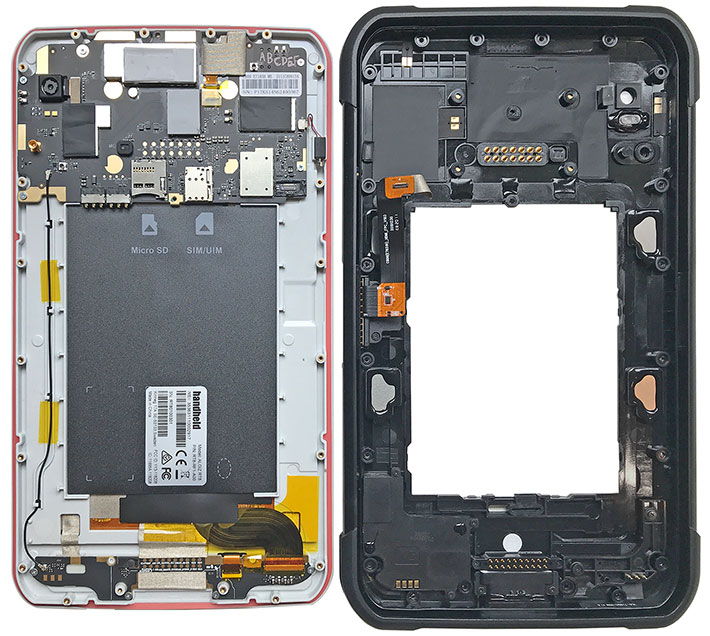
Another thing you don't see inside the Algiz RT8 is a metal frame that provides strength and a solid surface to mount all the electronics on. It's not really needed in an Android device, and the slender polycarbonate housing is plenty strong and rigid. Cooling, likewise, simply isn't an issue in a state-of-the-art Android design.
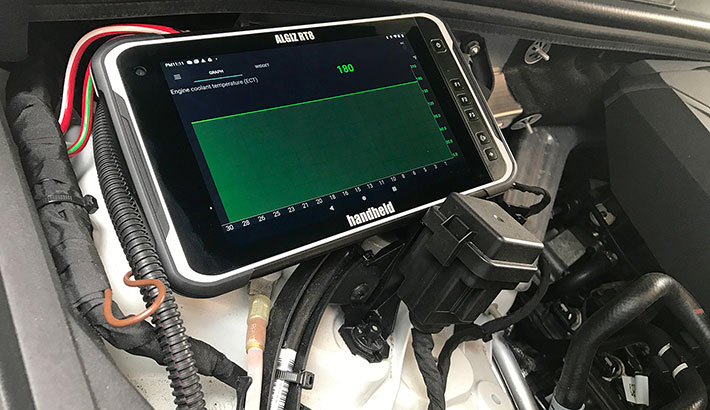
The technology under the hood
Assessing the technology and performance of an Android device is quite different from that of a Windows/Intel device. Those are fairly easily pegged. After reviewing and benchmarking Wintel devices for decades, one look at the spec sheet is usually enough to get an idea of where a device fits into the performance landscape.
Smartphones and Android-based handhelds may come with processors from Qualcomm, nVidia, Samsung, Mediatek and other licensees of the ARM architecture that dominates smartphones. And there seems to be little of the brand loyalty that can be seen in desktops and laptops. Over the years, Handheld itself has been using different CPU vendors for its Algiz and Nautiz models.
 For the Algiz RT8, Handheld chose an octa-core "Snapdragon" 625 MSM8953 processor from Qualcomm, a popular chip found in numerous commercial smartphones and tablets as well as Handheld's rugged Nautiz X6 handheld. The MSM8953 is based on the ARMv8-A 64-bit instruction set, and the Cortex-A53 is the successor to the popular Cortex-A7. For graphics, the MSM8953 includes an Adreno 506 GPU running at up to 650MHz. For the Algiz RT8, Handheld chose an octa-core "Snapdragon" 625 MSM8953 processor from Qualcomm, a popular chip found in numerous commercial smartphones and tablets as well as Handheld's rugged Nautiz X6 handheld. The MSM8953 is based on the ARMv8-A 64-bit instruction set, and the Cortex-A53 is the successor to the popular Cortex-A7. For graphics, the MSM8953 includes an Adreno 506 GPU running at up to 650MHz.
Qualcomm introduced the Snapdragon 625 mobile platform, of which the MSM8953 is a part of, as a robust, power-efficient processor platform for high-end smartphones. It includes an integrated X9 LTE modem with very fast upload speed as well as advanced 802.11ac Wi-Fi, 4K video support, enhanced photography processing, realistic 3D imagery, and the latest graphics APIs (see Snapdragon 625 info sheet)
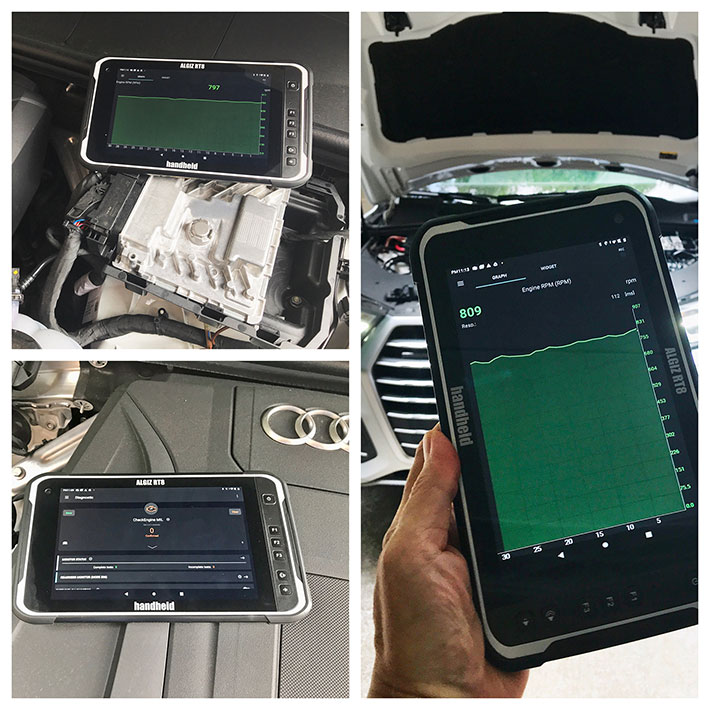
In our benchmark testing (Vellamo Browser/Metal/Multi-Core, AnTuTu, and PassMark Mobile), the Handheld Algiz RT8 did well, scoring roughly three times as high as the Handheld Group's older initial Nautiz X2 and twice as high as the ultra-rugged Nautiz X9.
There's 64GB of internal mass storage, which can be complemented with up to 128GB via micro-SDXC card. For navigation, the spec sheet suggests that the dedicated u-blox GNSS positioning receiver in the Algiz RT8 supports not just the American GPS, but also the GLONASS, Beidou, and Galileo satellite systems. Access to more satellites can increase reception in difficult areas.
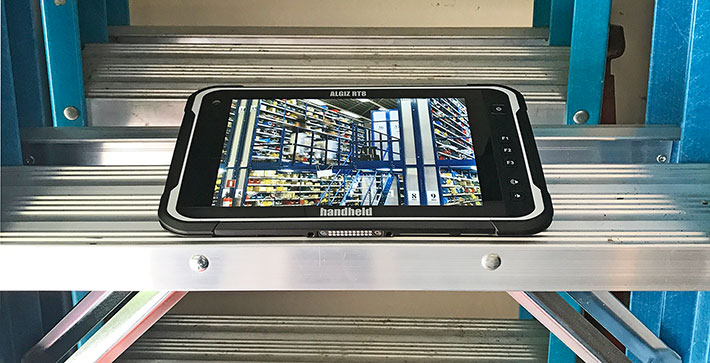
Function keys
As an Android-based capacitive multi-touch tablet, the Algiz RT8 doesn't have or need a physical keypad or buttons. However, there are times when having actual buttons comes in handy. Sometimes a quick button push works quicker and better than first locating and launching an app. Or it rains or you wear thick gloves.
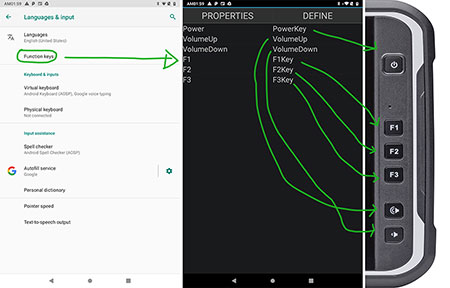 For those kinds of situations the Algiz RT8 offers, in addition to the power button, five programmable function keys. For those kinds of situations the Algiz RT8 offers, in addition to the power button, five programmable function keys.
Assigning functions to them is done in Settings -- System -- Languages & Input -- Function keys (yes, four levels deep).
Here you can assign functions F1 through F12, which can come in very handy if you run ported Windows apps or terminal-emulation screens that use PC-style functions keys. You can also link apps and custom actions to the function keys.
Even though the volume up and down hardware keys have speaker labels printed on them, those two keys can also be linked to any function.
In our review unit we assigned the three default Android functions — Back, Home, and Task Switching — to F1, F2, and F3. It would have been nice to double the number of functions via short and long presses, but that is not available.
We are tempted to vent a bit here about Google's terrible habit of constantly tinkering with the Android user interface, haphazardly moving functions around, and/or renaming them in with each new version, thus needlessly adding complexity. This utterly negates one of Android's inherent advantages, that billions of people use it and are familiar with it. A second gripe is Google's increasing heavy-handedness in tying Android to itself by requiring a Google account and endlessly pushing Google services. Skillful suppliers such as Handheld do what they can to configure the interface as cleanly and optimally as possible and weeding out intruding commercialism, but that's only possible to a degree. Let's hope Google will come to its senses.
Cameras don't rival premium smartphones, but good enough
The Handheld Algiz RT8 has two cameras. The one facing the user has a 5-megapixel imager and is for video calling and conferencing. The rear-facing camera has auto-focus, a 13-megapixel imager, and an LED flash. Both can do still pictures and video. The rear camera can be used to visually document work status, progress, completion, etc. While virtually everyone carries a smartphone with good cameras these days, it may still be advantageous to record and store all data with one device rather than using multiple ones.
Cameras integrated into vertical and industrial market tablet computers have historically underperformed compared to dedicated cameras and, more recently, even more so compared to smartphone cameras with their sophisticated apps and features. Integrated cameras have improved substantially over the past few years, to the point where they were often good enough to eliminate the need of taking along a dedicated camera or smartphone if photo or video documentation was needed on the job.
Over the past two or three years, we've seen a leveling off of integrated camera quality and ease of use, as if manufacturers had decided that smartphones have became so pervasive and their cameras so good as to render cameras integrated into rugged tablets irrelevant.
Android systems, however, has always had much better integrated camera support than Windows-based computers, especially on the software side, and that applies to the cameras in the Algiz RT8 as well.
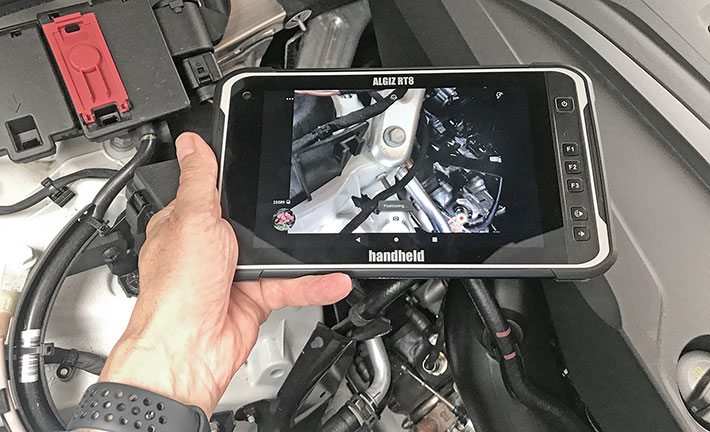
The Camera app in the Algiz RT8 is simple, intuitive and easy to use. Unlike the Windows Camera app that is extremely limited, the Algiz 8 camera app has scene settings, GPS location, face detection, a continuous shot mode, redeye reduction, white balance modes, and over 20 images sizes in various aspect ratios. You can shoot pictures either in 4:3 or 16:9 format, and video in various resolutions. There is also a "ProMode" that enables a degree of manual control for ISO (100-1600), exposure (+/- 2EV), white balance (5 modes) and focus (macro to infinity).
Below are sample pictures shot with the Algiz RT8 rear camera in its highest resolution, which is 4160 x 3120 pixels in 4:3 aspect ratio format (click the image compilation for a full size version):
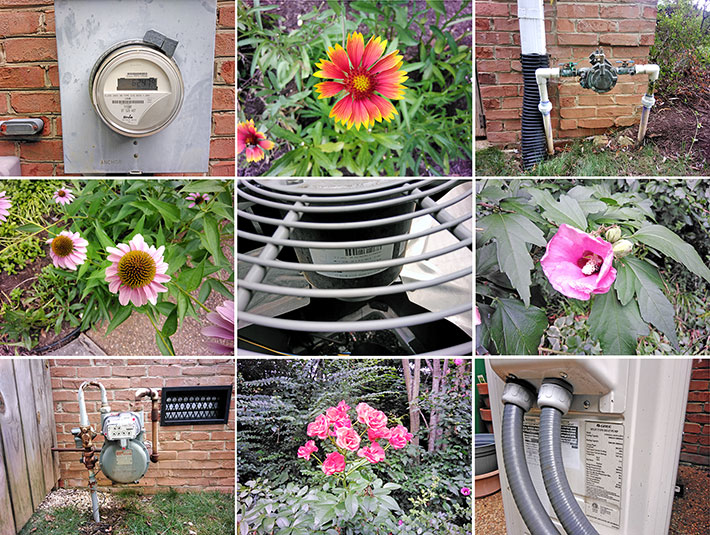
The documentation camera can shoot very serviceable 4K video, and it, too, has some nice features. A time lapse mode allows shooting in intervals from half a second to 24 hours, there's video rotation, users can select audio (AMRNB or AAC) and video (MEG4, H264, H265) encoders, there's selectable noise reduction, and more.
The Algiz RT8's integrated cameras don't quite match the incredibly advanced and powerful cameras in today's premium smartphones, but they are good enough for the jobs intended.
Bright and very good 8-inch display
The Algiz RT8 tablet's 8.0-inch display offers 1920 x 1200 pixel resolution, making for 16:10 aspect ratio and a crisp 283 pixels per inch. That is more than any of the current Apple iPad Pro models and clearly qualifies for "retina" sharpness and quality in the sense that you can no longer see individual pixels from the typical viewing distance.
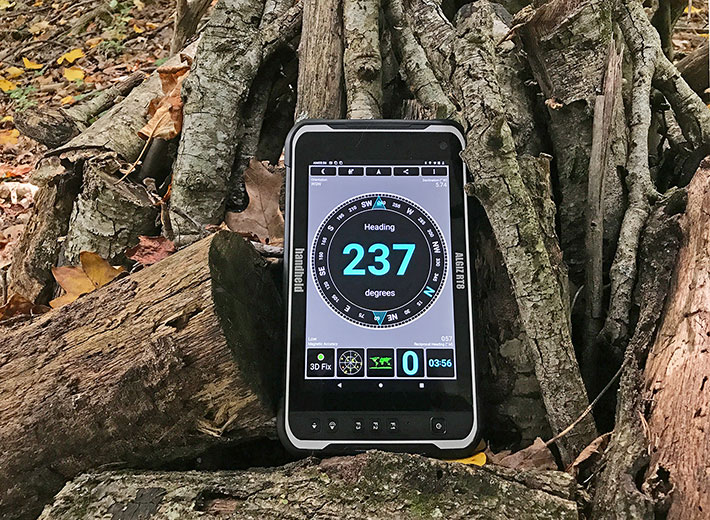
The 8-inch diagonal LCD size essentially splits the difference between one of today's big smartphones in the 6.5-inch range and the standard iPad class tablets in the 10-inch range. The Algiz RT8, however, is, and feels, a LOT larger than even the biggest smartphone, in part thanks to the generous margin around its display. That, and the additional screen size, makes it easy to hold the RT8 and work with it. How does the Algiz RT8 compare in resolution with its Algiz 8X Windows-based sibling? Big difference there. The RT8 has more than twice as many pixels than the 8X on the same size screen.
 That said, resolution alone isn't everything, especially not with displays that are often, or predominantly, used outdoors and in broad daylight. It's one thing for a display to look good indoors, and quite another doing so outdoors with its much higher brightness, the sun, and reflections everywhere. That said, resolution alone isn't everything, especially not with displays that are often, or predominantly, used outdoors and in broad daylight. It's one thing for a display to look good indoors, and quite another doing so outdoors with its much higher brightness, the sun, and reflections everywhere.
Over the past decade, the industry has done a remarkable job addressing those issues. Reducing the display's internal reflection of ambient light via polarizers, filters, coatings and elimination of air spaces between the various layers of the LCD, in conjunction with a strong backlight, helped to make screens viewable outdoors.
However, even with the best currently available technology, outdoor viewability remains a challenge, one where numerous factors must be carefully optimized and balanced against each other.
Almost all modern displays have a glossy surface. That's in part because gloss makes colors vibrant and pictures come to life, but that comes at the cost of external reflections. Gloss also is best for optimal implementation of capacitive multi-touch, where the surface must be as smooth and stiction-free as possible.
What does all that mean for the display used in the Algiz RT8? To illustrate that we shot a number of test pictures (see below) in different lighting conditions. All images were shot at the same time, around noon, on a fairly sunny East Tennessee mid-summer day.
Starting with the two images on top, taken in lightly shaded areas, you can see that the 465-nits display of the Algiz RT8 is bright for outdoor use. However, just as is the case with pretty much any smartphone and modern tablet, you have to deal with reflections and hold the screen so that they are minimized.
The screen is bright and vibrant enough for daylight outdoor use, but it's a matter of holding it right, or else the picture can give way to reflection.
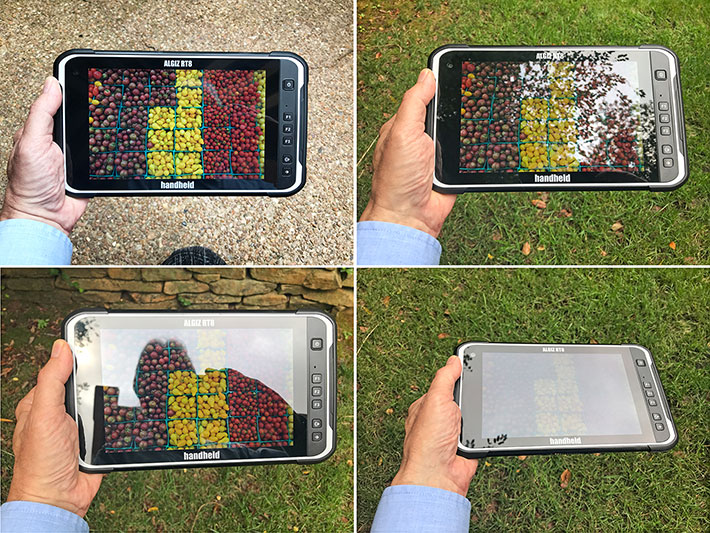
Viewing angle is a display quality that is just as important, and perhaps even more important, than brightness. Older LCD technologies required looking at the display head-on to get a true picture. Viewing from an angle would dim the image and/or change colors and contrast. The Algiz RT8 display has no such issues. Display brightness, colors, and contrast do not change no matter what angle you view the display from, and there is also no annoying tint that often mars even good wide viewing angle screens. Very well done.
Overall, the RT8 display is a pleasure to use. It's bright enough, very vibrant, and very sharp. Like most glossy capacitive touch displays, the Algiz RT8 is prone to fingerprints and other smudging. Overall, however, given the current state of display technology, this is an altogether excellent screen.
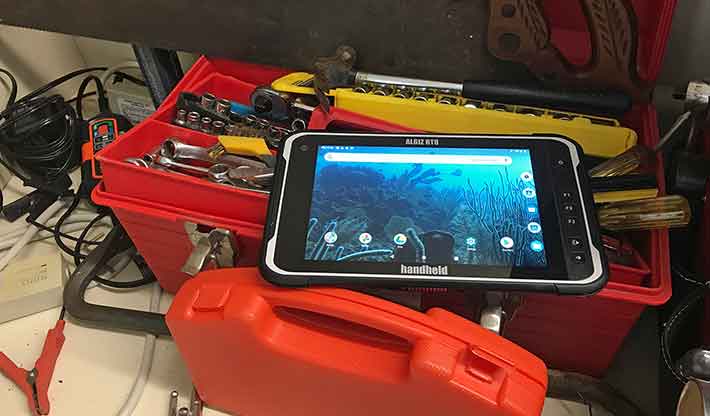
Tough and rugged for the field
As far as ruggedness goes, in its news release announcing the Algiz RT8 Handheld said that "the new Algiz RT8 ultra-rugged tablet is prepared for whatever the outside environment delivers — extreme temperatures, vibration, drops, water, and dust." And the tablet lives up to that with a very wide operating temperature range from -4 to 140 degrees Fahrenheit (-20 to 60 Celsius). It carries IP67 sealing where the "6" means the computer is totally protected from dust, and the "7" that it can handle even total immersion in water down to about a meter (3.3 feet). 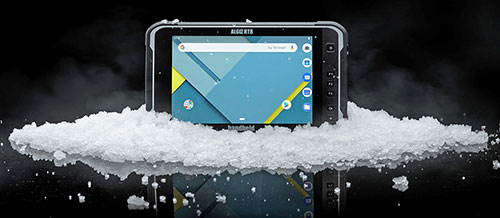 The Algiz RT also passed the MIL-STD-810G 516.6. Procedure IV test of 26 drops from a height of four feet to concrete. What does all this mean?
The Algiz RT also passed the MIL-STD-810G 516.6. Procedure IV test of 26 drops from a height of four feet to concrete. What does all this mean?
As far as operating temperature goes, the device can be used in most environments where someone would be expected to work with a computer. The folks at the Handheld Group's native Sweden know a thing or two about ice and snow and working in the cold, so we're sure they have low temperature suitability covered.
Ample protection and cushioning make the unit immune to damage from drops from four feet (and we think it can likely handle more), which is about the height it may fall while being used in a standing position. Here, the Algiz RT8's modest weight and the protective all-around bumpers provide excellent shock resistance.
We criticized Handheld's smaller RT7 tablet for not having an IP67 rating because we think that degree of protection is increasingly expected in small mobile computing devices, be they smartphones or tablets. We feel that an IP67 ingress protection rating gives field workers the degree of confidence in their devices that they need on the job. No one uses a tablet to work underwater, but it's quite possible that it may accidentally drop into a creek or big puddle, and then it's really good to know that won't be the end of the device.
Vibration resistance is necessary because RT8 tablets may well see duty mounted in vehicles, and so Handheld tested the tablet as described in MIL-STD-810G, Method 514.6, Procedures I & II, for general vibration in a fixed mounting and a loose cargo test.
The Algiz RT8 can handle operating altitudes up to 15,000 feet, and was tested according to MIL-STD-810G, Method 507.5 for humidity resistance.
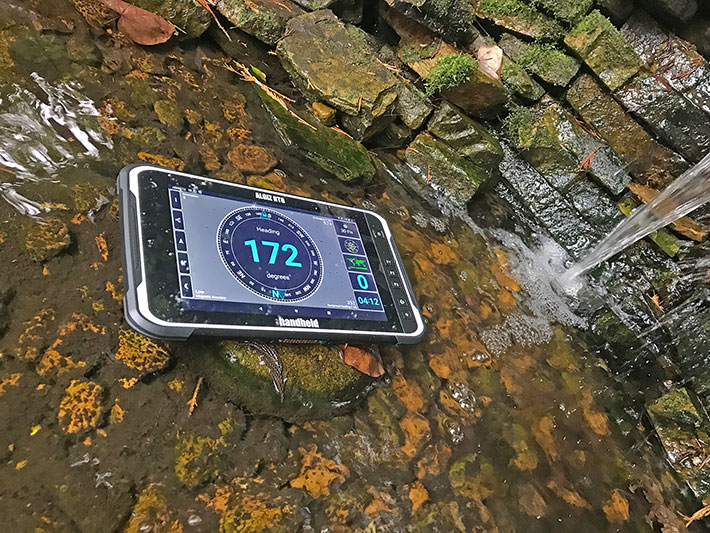
While some customers will probably want to see actual lab reports with more specific detail (a certificate of compliance is available here), the overall impression of the Algiz RT8 is that it's indeed a very rugged device that will likely be able to handle a good deal of abuse. It'd be good to know the version of Gorilla Glass used in the device, as Corning has been steadily improving it since its inception in 2007.
Summary: Handheld Algiz RT8
The Algiz RT8 is a perfectly logical addition to the Handheld Group's lineup. Tablet customers now have their choice not only of two compact rugged Windows tablets, but also two logically sized and well implemented Android tablets. In essence, with the Algiz RT8, Handheld gives customers Android, the OS they already know inside and out, on a bigger screen than any smartphone has, and in a package that's much more durable and much more functional.
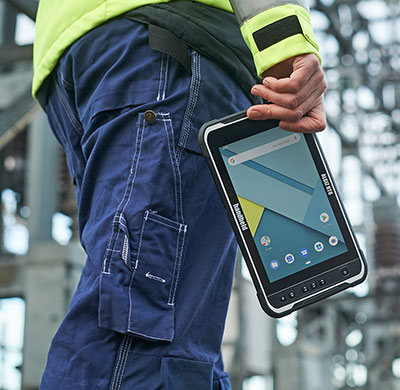
What sets the Algiz RT8 apart is its sheer practicality. Unlike modern smartphones and many consumer tablets that you can barely touch without inadvertently triggering some action on the screen, the Algiz RT8 has a generous bezel margin around its display. You can comfortably hold this tablet. The Algiz RT8, despite its slender profile, also feels sturdy and solid; you never feel it needs to be babied.
The 8.0-inch daylight-viewable capacitive multi-touch display with its high 1920 x 1200 pixel resolution is bright, crisp, and very sharp. It offers perfect viewing from all angles, without any color, hue or contrast shifts whatsoever. Like almost all glossy capacitive touch displays it's prone to reflections, but overall this is an excellent display that's very pleasant to use and work on. In addition, users will appreciate its programmable hardware buttons.
The Algiz RT8 is rugged enough for use in almost any environment, it is well protected against impact, and it is largely immune to scratching. Like most small non-Windows tablets, onboard wired connectivity is limited, here to just a USB Type-C port and an audio jack; everything else (LAN, USB, HDMI, etc.) is done via dock. There is fast 802.11ac dual-band WiFi, WWAN, Bluetooth 4.1, a powerful easily accessible battery, concurrent dedicated GNSS, a full complement of sensors, and an interface to bolt-on expansion modules.
In summary, the new Handheld Algiz RT8 meets the needs of anyone who's been looking for a modern, and very compact Android tablet for work even under the most demanding environmental conditions. -- Conrad H. Blickenstorfer, August 2020
Handheld Group Algiz RT8 Specs:
| Status |
Added 02/2020, full review 08/2020
|
| Type |
Rugged Android tablet
|
| Processor |
Octa-core Qualcomm "Snapdragon" 625 |
| Processor speed |
2.00GHz |
| OS |
Android 9 (GMS)
|
| Graphics |
Adreno 506 |
| Memory |
4GB |
| Display type |
Sunlight-readable TFT LCD with Corning Gorilla Glass |
| Display resolution |
8.0" (1920 x 1200 pixel, 16:10 aspect ratio) 283 ppi, 465 nits as tested |
| Digitizer/Pens |
10-point capacitive multi-touch (incl. rain and glove modes)
|
| Buttons |
Power, F1, F2, F3, volume up/down |
| Storage |
64GB |
| Expansion |
1 x Micro SDXC (up to 128GB), 1 x Nano SIM |
| Housing |
Polymer plastic with protective rubber bumpers |
| Operating temperature |
-4 to 140 degrees Fahrenheit (-20 to 60 degrees centigrade) |
| Drops/shock |
26 drops from 1.2 m (4 ft) MIL-STD-810G, Method 516.6 Procedures IV
|
| Vibration |
MIL-STD-810G, Method 514.6 Procedure I
|
| Enclosure Class |
IP67, MIL-STD-810G, IEC 60529 |
| Altitude |
4572 m (15.000 ft)
MIL-STD-810G, Method 500.5 Procedures I & II |
| EMC/EMI |
MIL-STD-461F: CE101, CE102, CS101, CS114, CS115, CS116, RE101, RE102, RS101, RS103 |
| Hazardous materials |
unknown |
| Size |
9.8 x 5.7 x 0.5 inches (249 x 145 x 14.5 mm) |
| Weight |
1.4 pounds (635 grams)
|
| Power |
User-accessible, field-replaceable 3.8V 8,200mAh 31.2 watt-hour Li-Ion battery
|
| Camera |
5.0 MP (front), 13.0 MP with LED flash (rear)
|
| Sensors |
Gyroscope, compass, accelerometer, pressure, proximity, ambient light
|
| Communication |
802.11a/b/g/n/ac, Bluetooth v4.1, integrated u-blox GNSS (GPS, GLONASS, Galileo, BeiDou), NFC, 2G (850,900,1800,1900)/3G (1,2,5,8)/4G LTE (1,2,3,4,5,7,8,12,13,17,20,25,28,38,39,40,41)
|
| Interface |
1 x USB Type-C OTG, 1 x 3.5mm audio in/out, power, docking connector (supporting HDMI, Ethernet, USB), expansion connector in back
|
| Price |
Inquire
|
| Spec sheet |
 Algiz RT8 product brochure (PDF) Algiz RT8 product brochure (PDF) |
| Web page |
Handheld Group Algiz RT8 product page |
| Contact |
Handheld Group AB
Kinnegatan 17A
531 33 Lidköping, Sweden
Tel: +46 (0) 510 54 71 70
Fax: +46 (0) 510 282 05
Web: www.handheldgroup.com
Email: info at handheldgroup.com
|
HHCS Handheld USA Inc.
2121 NE Jack London Street, Suite 100
Corvallis, OR 97330, USA
Tel: (541) 752-0313
Fax: (541) 752-0338
Web: www.handheld-us.com
Email: info at handheld-us.com
|
|
(copyright 2020 RuggedPCReview.com)
|








 As usual, let's answer some basic questions first. Why a rugged 8-inch Android tablet when Handheld already has an excellent rugged 8-inch Windows tablet (the Algiz 8X)?
As usual, let's answer some basic questions first. Why a rugged 8-inch Android tablet when Handheld already has an excellent rugged 8-inch Windows tablet (the Algiz 8X)?





 Unlike the battery in Handheld's Windows 10-based Algiz 8X where the battery is part of the design and there is no battery compartment cover, the RT8 battery does require a cover that has a white silicone pressure seal around its entire perimeter.
Unlike the battery in Handheld's Windows 10-based Algiz 8X where the battery is part of the design and there is no battery compartment cover, the RT8 battery does require a cover that has a white silicone pressure seal around its entire perimeter.


 For the Algiz RT8, Handheld chose an octa-core "Snapdragon" 625 MSM8953 processor from Qualcomm, a popular chip found in numerous commercial smartphones and tablets as well as Handheld's rugged Nautiz X6 handheld. The MSM8953 is based on the ARMv8-A 64-bit instruction set, and the Cortex-A53 is the successor to the popular Cortex-A7. For graphics, the MSM8953 includes an Adreno 506 GPU running at up to 650MHz.
For the Algiz RT8, Handheld chose an octa-core "Snapdragon" 625 MSM8953 processor from Qualcomm, a popular chip found in numerous commercial smartphones and tablets as well as Handheld's rugged Nautiz X6 handheld. The MSM8953 is based on the ARMv8-A 64-bit instruction set, and the Cortex-A53 is the successor to the popular Cortex-A7. For graphics, the MSM8953 includes an Adreno 506 GPU running at up to 650MHz.


 For those kinds of situations the Algiz RT8 offers, in addition to the power button, five programmable function keys.
For those kinds of situations the Algiz RT8 offers, in addition to the power button, five programmable function keys.



 That said, resolution alone isn't everything, especially not with displays that are often, or predominantly, used outdoors and in broad daylight. It's one thing for a display to look good indoors, and quite another doing so outdoors with its much higher brightness, the sun, and reflections everywhere.
That said, resolution alone isn't everything, especially not with displays that are often, or predominantly, used outdoors and in broad daylight. It's one thing for a display to look good indoors, and quite another doing so outdoors with its much higher brightness, the sun, and reflections everywhere.


 The Algiz RT also passed the MIL-STD-810G 516.6. Procedure IV test of 26 drops from a height of four feet to concrete. What does all this mean?
The Algiz RT also passed the MIL-STD-810G 516.6. Procedure IV test of 26 drops from a height of four feet to concrete. What does all this mean?


